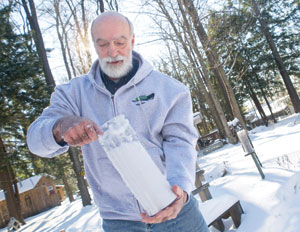
February 2, 2015
Willet man keeps trained eye on the sky
 Joe McIntyre/staff photographer
Joe McIntyre/staff photographer Robert Rosati, of Willet, shown collecting a core sample of snow outside his Willet home Saturday, serves as a weather spotter, collecting data for the National Weather Service.
WILLET — Each morning, Robert Rosati walks out his front door and records the amount of snow on his snow board, a board with a white surface and a stake through the center. The white surface is important to keep the snow from melting before he measures it, he says.
He then thrusts a yardstick into the snow in several places, writing down the average of the depth, before taking a snow-gauge inside to melt the white, fluffy stuff and measure how much water is left.
Rosati, a retired employee with the state Department of Environmental Conservation, collects data on weather patterns that the National Weather Service studies, a hobby he says he enjoys and one meteorologists say is crucial to helping them perform their jobs.
One of Rosati’s tasks involves acting as a weather spotter for the National Weather Service, or calling in information about severe weather such as flooding, heavy rain, or hail or ice accumulations.
There are about 40 volunteer weather spotters like Rosati in Cortland County, said Erik Heden, a meteorologist with the National Weather Service in Binghamton.
“The trained eye of our storm spotters are still our greatest asset, without a doubt,” he said, adding spotters provide valuable information about what is happening on the ground to meteorologists who study the radar.
Each year, the organization strives to hold a class in every county, focusing on measuring snow during the winter or tracking severe weather such as hail during the summer, Heden said. He added that the number of people taking the courses has drastically increased over the last five years.
Classes in larger cities used to run about 40 people but now have 75 to 100 participants, and those in smaller areas like Cortland have increased from five to 10 attendees to 20 or 25, Heden said.
He credits the organization’s use of social media in catching the attention of potential spotters and he lauds retention techniques, such as “aggressively” emailing former spotters, saying that helps keep people involved in collecting data on theweather.
Every day, Rosati also collects data for the Community Collaborative Rain, Hail and Snow Network or CoCoRaHS, anonline system that records weather-related information from people around the country.
The information is used by various organizations, including the National Weather Service. He can report the data at any time, but CoCoRaHS prefers getting information on a 24-hour-cycle. As part of his work for the organization, he also takes “core samples” of snow once a week from the ground, which he melts inside to determine how much water would be on top of the frozen ground if there was a thaw and rain came.
Rosati first became involved in studying the weather in the mid-1990s and said his interest in the hobby stemmed from his career with the DEC. During his 35-year tenure with the state agency, he monitored potential high water periods for flood control purposes.
Measuring rainfall was important to him in his work, and he knows others such as farmers and contractors continue to need that kind of data, too, he said.
“You volunteer for certain things, and this, it’s important to me,” Rosati said.
To read this article and more, pick up today's Cortland Standard
Click here to subscribe